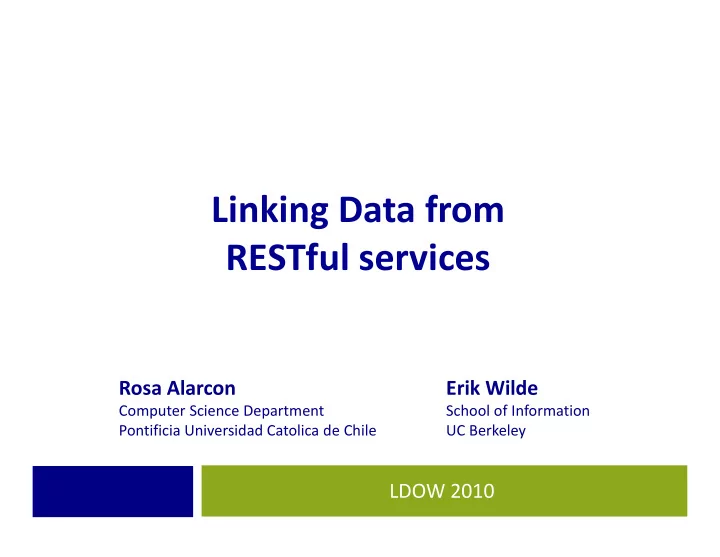

Linking Data from RESTful services f l R Rosa Alarcon Al E ik Wild Erik Wilde Computer Science Department School of Information Pontificia Universidad Catolica de Chile UC Berkeley LDOW 2010
Abstract 2 � Semantic Web goal: extend current human ‐ readable Web resources with semantic information encoded in machine ‐ h f d d h processable form � Web of Data: Linked Data principles, several data sources compliant with the Semantic Web technologies, such as, RDF li i h h S i W b h l i h RDF triple stores, and SPARQL endpoints � REST: a set of the architectural principles that underlie the h human ‐ readable Web d bl W b � To provide a mechanism for describing REST (i.e. human ‐ readable Web) resources and transform them into semantic resources � Lower entry barrier LDOW ‐ 2010
REST (Representational State Transfer) ( p ) 3 � Resources have unique, opaque identifiers � Resources have unique, opaque identifiers � Avoid coupling between clients and servers � Uniform interface: methods with know semantics that change the state of resources � HTTP: GET, PUT, DELETE, POST, OPTIONS � Resources (conceptual) have multiple representations � JSON, XML, XHTML, etc. JSON XML XHTML t � Hyperlinks � Related resources + State change � Related resources + State change LDOW ‐ 2010
ReLL: Resource Linking Language g g g 4 LDOW ‐ 2010
ReLL Description Schema p 5 LDOW ‐ 2010
ReLL Snippet: Describing the ISchool pp g 6 <service … targetNamespace = "http://rell.org/school/” … > < resource xml:id = " person "> < resource xml:id = person > <name> … <desc> … < uri match="http://.*?/people/(faculty|students|staff|visitors)/[a ‐ zA ‐ Z]+" type="regex"/> < representation xml:id=" person ‐ html " type="iana:text/html"> t ti l id " ht l " t "i t t/ht l" <name> … < link xml:id="person ‐ website" type="website"> < selector select="//div[@class = 'field ‐ field ‐ person ‐ website']//a/@href" type="xpath"/> </link> < link xml:id=" person ‐ course " type=" personcourse " target="course"> < selector select="//span[@class = 'views ‐ field ‐ title']/a/@href" type="xpath"/> // p [ ]/ / yp p / < protocol type="http"> < request method="get"/> < response media="iana:html"/> </protocol> </protocol> </link> </representation> LDOW – 2010 </resource>
From ReLL to RDF 7
Implementation: RESTler p 8 LDOW ‐ 2010
Crawled REST Services 9
Crawled REST Resources 10 LDOW ‐ 2010
11 Generated Generated RDF LDOW ‐ 2010
Getting RDF from Resources g 12 LDOW ‐ 2010
ISchool Camera SPARQL 13 LDOW ‐ 2010
Conclusions 14 � Do RESTful services even should be described? � Do RESTful services even should be described? � Descriptions introduce coupling between service provider and consumer. � Shared set of assumptions & preconditions that facilitates documentation, understanding, & change identification (e.g. new ids, access schemes or representation format), so that clients and serves can react appropriately (e.g. alerting the client manager, attempting a fallback, or abort). � Mostly useful for automatic agents that translate the contract into RDF triples. � Hence, ReLL can achieve loose coupling and still allow clients to behave when the unexpected ll li t t b h h th t d occurs. LDOW ‐ 2010
Conclusions 15 � Limitations � Limitations � Static description of RESTful services (new resources, and changes ignored) � Design a ReLL document for each REST service (e.g. Virtuoso’s Sponger) � Design a speci fi c XSLT for each resource type to harvest information D i i fi XSLT f h t t h t i f ti � On the bright side � Web technologies (e.g. XPath, XSLT and XML) familiar to Web developers � Web technologies (e.g. XPath, XSLT and XML) familiar to Web developers � Future work � Dynamic and automatic generation of ReLL descriptions; may require information retrieval, text mining and probably machine learning techniques � Complex REST models (e.g. methods such as PUT, DELETE and POST) � Include Linked Data vocabularies LDOW ‐ 2010
Recommend
More recommend